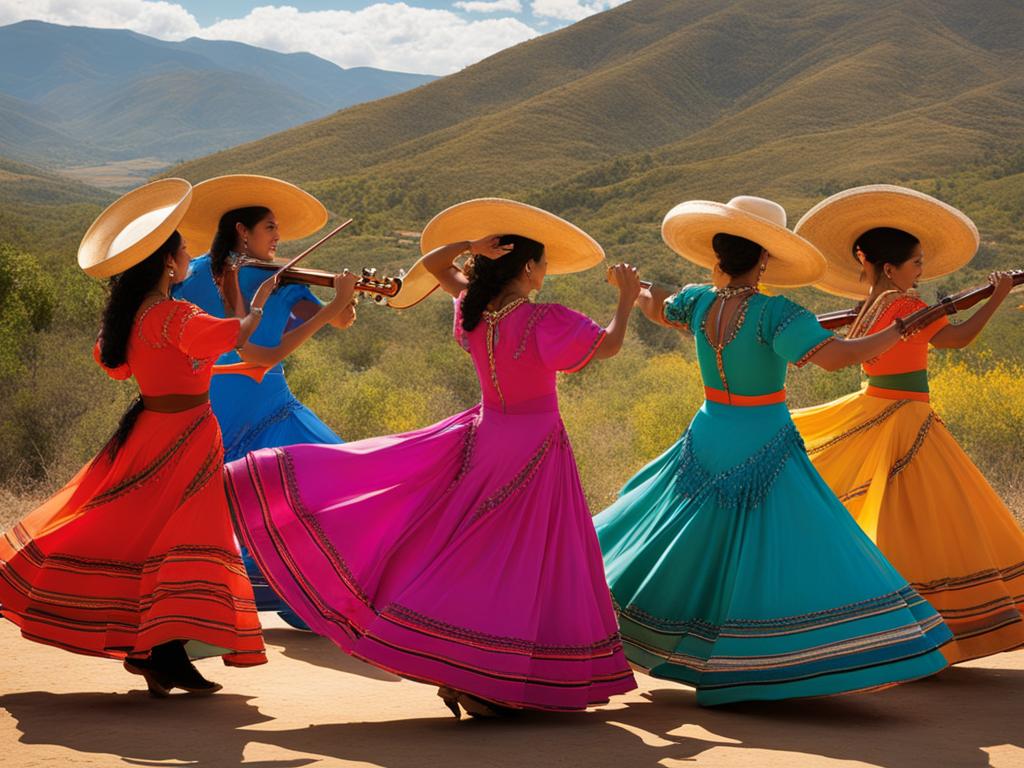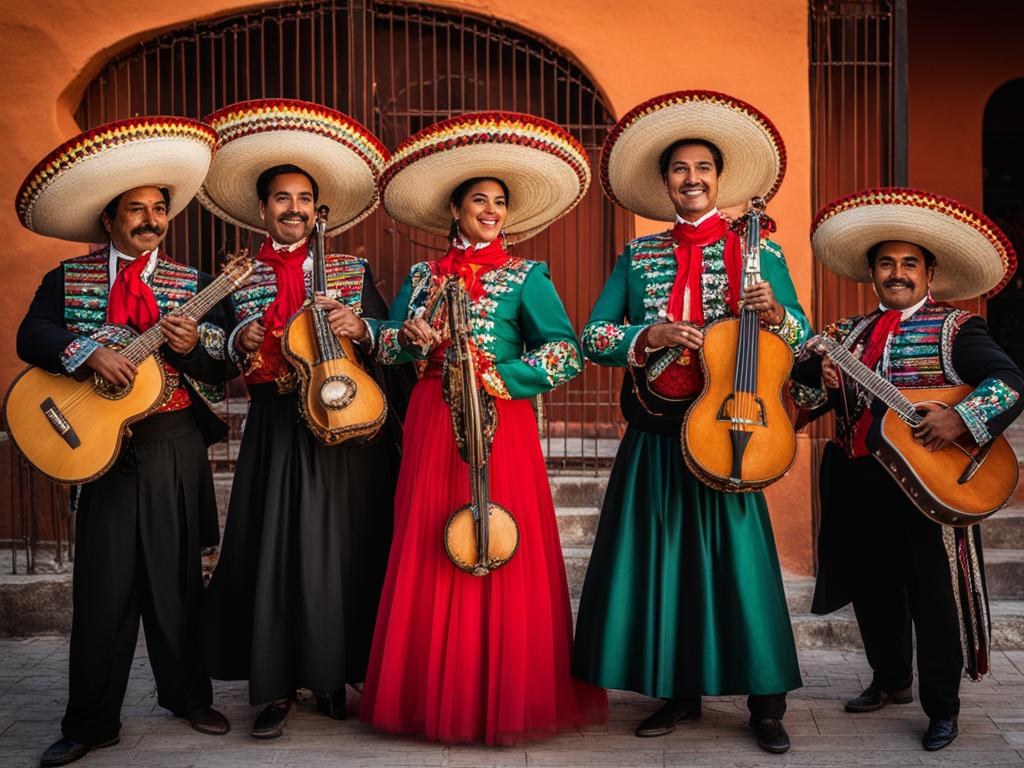Mexico’s rich and diverse musical heritage is a reflection of its cultural history, blending indigenous traditions with European influences brought by Spanish colonization. The roots of Mexican music can be traced back to ancient civilizations such as the Aztecs and Mayans, who used music as a form of communication, celebration, and religious expression. The arrival of the Spanish in the 16th century brought European musical elements, which merged with indigenous rhythms and melodies to create a unique Mexican sound. This fusion gave birth to a wide range of genres and styles, including mariachi, banda, ranchera, cumbia, and more, all of which contribute to the vibrant music scene in Mexico.
Key Takeaways:
- Mexican music is a blend of indigenous traditions and European influences.
- Ancient civilizations like the Aztecs and Mayans used music as a form of communication and celebration.
- The fusion of European and indigenous elements gave rise to a variety of Mexican music genres.
- Mexico has a vibrant music scene with genres such as mariachi, banda, ranchera, and cumbia.
- Mexican music reflects the rich cultural heritage and traditions of the country.
Traditional Mexican Music Genres
Traditional Mexican music genres have a deep-rooted history and have been passed down through generations. These genres are characterized by their unique instrumentation, lyrical themes, and rhythmic patterns, showcasing the rich tapestry of Mexican music.
Some of the most prominent traditional Mexican music genres include bolero, son jarocho, and jarana. Each genre has its distinct style and holds a special place in Mexican culture. These genres are often performed using traditional instruments such as guitars, drums, and various string instruments.
Bolero is a genre known for its romantic melodies and heartfelt lyrics. It originated in Cuba but gained popularity in Mexico, becoming an integral part of traditional Mexican music.
Son jarocho, originating from the state of Veracruz, is characterized by its lively rhythms and the use of instruments such as the jarana, a small guitar-like instrument, and the harp. This genre often features improvised verses and is deeply rooted in Mexican folk traditions.
Jarana, also originating from Veracruz, is a traditional dance genre that combines elements of African, Spanish, and indigenous music. It is often performed by groups of musicians and dancers, creating a festive atmosphere.
These traditional Mexican music genres are a testament to the cultural heritage of Mexico, capturing the essence of the country’s rich history and traditions. They continue to be celebrated and performed, keeping the spirit of Mexican folk music alive.
Mariachi Music: The Iconic Genre
Mariachi music is the epitome of Mexican music, renowned for its lively and captivating melodies that embody the spirit and vibrancy of Mexico. Originating in the state of Jalisco, mariachi music has become a beloved genre throughout the country and beyond, representing the rich cultural heritage and traditions of Mexico.
Mariachi music is characterized by its vibrant instrumentation, including the soul-stirring sound of the trumpet, the rhythmic strumming of the guitar, and the deep resonance of the guitarrón, a large bass guitar that serves as the backbone of the ensemble. These instruments, combined with the melodious vocals of the mariachi singers, create a harmonious and uplifting experience that enchants audiences.

Mariachi music is often associated with festive occasions and celebrations, where mariachi bands don traditional charro outfits, consisting of ornate, embroidered suits that showcase the grandeur and elegance of Mexican culture. The spirited performances of mariachi bands, filled with energy and emotion, make them a centerpiece of any event, captivating listeners with their charismatic presence.
Lyrically, mariachi songs often delve into universal themes of love, heartbreak, and the experiences of everyday life, allowing listeners to connect deeply with the music and relate to the emotions expressed. These songs serve as an avenue for storytelling, showcasing the rich history, traditions, and mythology of Mexico.
Today, mariachi bands can be found throughout Mexico, from the bustling streets of Mexico City to the charming plazas of Guadalajara. These talented musicians continue to captivate audiences with their skillful performances, preserving the legacy of mariachi music and ensuring its endurance for generations to come.
Ranchera Music: A Window into Mexican Folk Traditions
Ranchera music holds a special place in Mexican folk traditions and serves as a captivating window into the country’s cultural heritage. Rooted in rural life and deeply connected to the working class, ranchera songs resonate with the spirit and emotions of the Mexican people.
The essence of ranchera music lies in its heartfelt lyrics, which often tell stories of love, patriotism, and the struggles of everyday life. Through passionate singing and soulful melodies, ranchera songs reflect the joys and sorrows of the human experience.
To accompany the poignant lyrics, ranchera music utilizes traditional instruments that add depth and richness to the compositions. The guitar, a staple of Mexican music, forms the foundation of the sound, providing a melodic backdrop. The vihuela, a small guitar-like instrument, adds a distinct rhythm, while the accordion contributes harmonies that create a unique and authentic Mexican sound.
Iconic ranchera singers like Vicente Fernandez and Pedro Infante have achieved legendary status in Mexican music. Their powerful performances and exceptional vocal abilities have made them beloved figures in the genre, leaving an enduring legacy that continues to inspire and influence generations of musicians.

The cultural significance of ranchera music extends beyond its captivating melodies and impassioned storytelling. It serves as a tangible representation of Mexican folk traditions and a source of pride for the Mexican people. Ranchera music has become an integral part of Mexican identity, reflecting the traditions, struggles, and triumphs of the country.
Through ranchera music, listeners are transported to a world where emotions are laid bare and stories are shared with heartfelt sincerity. It is a musical genre that encapsulates the essence of Mexican folklore, offering a glimpse into the rich tapestry of Mexican culture.
Banda Music: The Power of Brass and Percussion
Banda music is a dynamic and lively genre known for its powerful brass and percussion instrumentation. Originating in the state of Sinaloa, Mexico, banda music has gained popularity not only within the country but also among Mexican communities worldwide. With its energetic rhythms and catchy melodies, banda songs are a favorite choice for celebrations and dance parties.
The heart of banda music lies in its brass section, which includes instruments such as trumpets, trombones, and tubas. These brass instruments create a vibrant and full-bodied sound that sets the tone for the entire ensemble. The powerful notes played by the brass instruments are complemented by the driving beats of drums and other percussion instruments, adding depth and excitement to the music.
Banda songs often feature lively rhythms that get people on their feet and moving. The infectious melodies and energetic performances make banda music perfect for festive occasions and create an atmosphere of celebration. Whether it’s a joyous event or a lively gathering, banda music sets the stage for a memorable and spirited experience.

Norteño Music: A Northern Mexican Tradition
Norteño, also known as música norteña, is a lively and energetic genre that originated in the northern regions of Mexico, particularly along the border with the United States. Influenced by both Mexican folk traditions and American country music, norteño music has a distinct sound that combines the best of both worlds.

The core instruments in norteño music are the accordion and the bajo sexto, a twelve-string guitar. These instruments create the signature sound that defines the genre, with their upbeat melodies and rhythmic accompaniment. The accordion adds a vibrant and melodic element, while the bajo sexto provides the driving bass lines that give norteño music its unique groove.
Norteño songs often depict the realities of life in the border region, telling stories of love, immigration, and the struggles faced by working-class communities. The lyrics are heartfelt and relatable, making norteño music a powerful form of expression for many.
Whether it’s the infectious melodies, the driving rhythm, or the heartfelt lyrics, norteño music continues to resonate with audiences both in Mexico and around the world. Its popularity has spread beyond its humble origins, captivating listeners with its lively and engaging sound.
Contemporary Mexican Music: Evolving Sounds and Global Recognition
While traditional Mexican music genres hold a special place in the hearts of the Mexican people, contemporary Mexican music has also gained widespread popularity and recognition both within Mexico and internationally. Contemporary Mexican music encompasses a wide range of genres and styles, incorporating elements from various musical traditions and reflecting the changing tastes and preferences of listeners. From Mexican rock to classical music, popular music, and electronic music, contemporary Mexican artists continue to push boundaries and experiment with new sounds, contributing to the vibrant music scene in Mexico.
In recent years, Mexican rock has emerged as a prominent genre within the contemporary music landscape. Influenced by international rock movements, Mexican rock artists infuse their music with elements of traditional Mexican culture, creating a unique and powerful sound. Bands like Molotov and Café Tacvba have achieved international fame, showcasing the talent and creativity of Mexican rock musicians.
Besides rock, classical music also thrives in Mexico. The country has a rich tradition of classical music, with renowned orchestras and talented composers. The Mexican classical music scene cultivates a deep appreciation for both traditional and contemporary classical pieces, showcasing the country’s commitment to artistic excellence.
Popular music in Mexico encompasses a diverse range of styles, including pop, hip-hop, and reggaeton. Mexican pop stars like Thalía and Alejandro Fernández have achieved worldwide recognition, bridging the gap between Mexican and international audiences. The popularity of reggaeton, a genre originating in Puerto Rico, has also reached Mexico, with Mexican artists infusing their own style and cultural influences into the music.
The music industry in Mexico has played a significant role in supporting and promoting contemporary Mexican music. Record labels, music festivals, and streaming platforms provide platforms for emerging and established artists to showcase their work and reach a wider audience. These initiatives contribute to the growth and success of the Mexican music industry.
Electronic music has also gained momentum in Mexico, with a growing number of electronic music producers and DJs making waves in the international scene. Festivals like Electric Daisy Carnival and BPM Festival attract music lovers from around the world, solidifying Mexico’s position as a destination for electronic music enthusiasts.
Fusion is an essential aspect of contemporary Mexican music, with artists blending different genres and musical traditions to create innovative sounds. By combining elements of Mexican folk music, rock, jazz, and other genres, musicians in Mexico continue to push the boundaries of creativity and experimentation. This fusion of styles contributes to the diversity and richness of contemporary Mexican music.
In conclusion, contemporary Mexican music represents the evolution of traditional genres and the emergence of new sounds and styles. Artists in Mexico continue to make a mark in the global music industry by blending elements of Mexican culture with international influences. Whether it’s Mexican rock, classical music, popular music, electronic music, or fusion, contemporary Mexican artists are shaping the vibrant music scene and gaining recognition on the global stage.

Fusion and Experimentation: Blurring Musical Boundaries
As the music industry continues to evolve, Mexican artists have embraced fusion and experimentation, blurring the boundaries between genres and creating unique sounds that defy classification.
One prominent genre that exemplifies this fusion is Latin alternative, also known as alterlatino. It combines elements of rock, electronic music, hip-hop, and traditional Latin American sounds, offering a fresh and unique perspective on Mexican and Latin American culture. Artists like Café Tacvba and Molotov have played a pivotal role in popularizing Latin alternative music, captivating listeners with their bold and innovative approach.
Mexican musicians have also made significant contributions to the world of Latin pop and reggaeton, two genres that have gained immense popularity globally. From the infectious beats of Latin pop icons like Thalía and Luis Miguel to the rhythmic grooves of reggaeton superstars like Daddy Yankee and J Balvin, Mexican artists have played a vital role in shaping these genres and propelling them to international success.
With its diverse range of genres and styles, the Mexican music scene continues to evolve and thrive. Artists are constantly pushing boundaries, experimenting with new sounds, and collaborating across genres to create music that defies categorization. This fusion and experimentation not only showcase the versatility and creativity of Mexican musicians but also exemplify the global influence of Mexican music on the world stage.

Mexican Artists Pushing Musical Boundaries
| Genre | Artists |
|---|---|
| Latin Alternative | Café Tacvba, Molotov |
| Latin Pop | Thalía, Luis Miguel |
| Reggaeton | Daddy Yankee, J Balvin |
| Hip-Hop | C-Kan, Cartel de Santa |
The table above highlights some of the influential Mexican artists who have been at the forefront of pushing musical boundaries. These artists have successfully blended genres, incorporated diverse influences, and created music that transcends traditional categorizations. Their groundbreaking work has not only garnered global recognition but has also paved the way for future generations of Mexican musicians to continue pushing the boundaries of musical expression.
The Cultural Impact: Mexican Music Icons and Global Recognition
Mexico has a rich musical heritage that has produced numerous talented and influential musicians who have made a significant impact on the global music scene. These Mexican and Latin American artists have achieved international fame and recognition, captivating audiences worldwide with their exceptional talent and passion for music. From legendary icons like Vicente Fernandez and Pedro Infante to rising stars like Luis Miguel and Paulina Rubio, these singers have left an indelible mark on the music industry.
Renowned for their powerful voices, emotional performances, and dedication to their craft, famous Mexican singers have garnered a massive following and earned accolades such as the prestigious Latin Grammy Awards. These awards not only recognize the artistic excellence of Mexican musicians but also serve as a testament to the universal appeal of Mexican music and its ability to touch hearts across cultural boundaries.
| Famous Mexican Singers | International Fame |
|---|---|
| Vicente Fernandez | Known as the “King of Ranchera Music,” Fernandez’s passionate vocals and charismatic stage presence have made him a beloved icon in the world of Mexican music. |
| Pedro Infante | Infante’s contributions to Mexican music and film have made him a beloved figure in Mexican culture, earning him the title of “The Idol of Mexico.” |
| Luis Miguel | With his smooth voice, Miguel has achieved international success and earned the title of “El Sol de México” (The Sun of Mexico), captivating audiences with his romantic ballads. |
| Paulina Rubio | Rubio’s catchy pop songs and electrifying performances have made her one of the most successful Latin American artists, achieving global recognition. |
One of the most iconic aspects of Mexican music is the mariachi genre, which has gained immense popularity both in Mexico and abroad. Mariachi bands, with their vibrant performances and traditional attire, have become synonymous with Mexican culture. Their energetic music and passionate singing have captured the hearts of audiences around the world and contributed to the promotion of traditional Mexican music on a global scale.

Through their remarkable talent, international fame, and awards, Mexican music icons have not only elevated the status of Mexican and Latin American music but have also become ambassadors of Mexican culture, spreading its rich traditions and vibrant spirit to audiences worldwide.
Also Read : Explore Top YouTube Christian Music Playlists
Conclusion
Mexican music and culture are deeply intertwined, reflecting the rich heritage and traditions of the country. From the iconic sounds of mariachi music to the vibrant regional music scene, Mexican music represents a tapestry of diverse genres and styles.
Traditional Mexican music genres, such as mariachi, banda, and ranchera, have roots that date back centuries, fusing indigenous rhythms with European influences. These genres continue to be celebrated and performed today, preserving Mexican traditions and captivating audiences with their heartfelt lyrics and passionate performances.
But Mexican music is not confined to the past. The contemporary music scene in Mexico is a melting pot of innovation and fusion, with artists experimenting and pushing boundaries. From Mexican rock to electronic music, Latin alternative to reggaeton, Mexican musicians have made significant contributions to global music trends.
Ultimately, Mexican music represents more than just a collection of melodies and rhythms. It is a cultural heritage that speaks to the identity and spirit of the Mexican people. By exploring and embracing Mexican music and culture, we can gain a deeper appreciation for the country’s artistic legacy and the unique ways in which music connects people.
FAQ
Q: What is the significance of traditional folk music in Mexican culture?
A: Traditional folk music holds great cultural importance in Mexico, as it reflects the country’s rich heritage and helps preserve its cultural identity. It is deeply rooted in the history and traditions of the Mexican people.
Q: How would you define the musical genre of huapango?
A: Huapango is a traditional musical genre in Mexico characterized by its lively rhythms and energetic dance forms. It originated in the southern part of the state and is widely celebrated for its vibrant and spirited nature.
Q: What are some examples of traditional Latin American musical styles?
A: Traditional Latin American music encompasses a wide range of musical styles such as rancheras, cumbia sonidera, and nortec collective, each representing the diverse cultural influences and regional variations within the Latin American music scene.
Q: What role does the violin play in Mexican folk music?
A: The violin is an integral instrument in Mexican folk music, contributing to the distinctive sound and melodic richness of the genre. Its expressive and emotive qualities enhance the traditional Mexican musical experience.
Q: How did the genre of rock and roll influence Mexican music in the 1960s and 1970s?
A: The genre of rock and roll had a significant impact on Mexican music during the 1960s and 1970s, leading to a fusion of traditional Mexican musical elements with the energetic and rebellious spirit of rock and roll, resulting in a unique and dynamic musical expression.
Q: Who are some influential figures in the Mexican music scene?
A: Influential figures in the Mexican music scene include revolutionary heroes like Jorge Negrete and Juan Gabriel, along with contemporary artists such as Natalia Lafourcade and the group Control Machete, all of whom have made lasting contributions to the genre of Mexican music.
Q: What are corridos and how do they contribute to the genre of Mexican music?
A: Corridos are a genre of Mexican folk music that narrate stories of historical events, social issues, and cultural themes. They play a significant role in preserving the history and oral traditions of Mexico, making them an essential part of the Mexican music genre.
Q: What are some characteristics of the musical style known as rock en español?
A: Rock en español is a popular Mexican musical style that emerged in the 1960s, characterized by its fusion of rock music with Spanish lyrics. It encompasses a diverse range of musical influences and has contributed to the global popularity of Mexican rock music.
Q: How do traditional Mexican musical styles, such as polka and vihuelas, showcase the diversity of the country’s music?
A: Traditional Mexican musical styles, including polka and vihuelas, reflect the diversity of Mexico’s music by incorporating regional rhythms, melodies, and instrumental techniques, resulting in a vibrant and varied musical landscape.
Q: What is the cultural significance of charro suits in the context of Mexican music?
A: Charro suits hold cultural significance in Mexican music as they are symbolic of the country’s rich cultural heritage. Worn by traditional musicians and mariachis, these elaborate suits are a visual representation of Mexico’s musical traditions and contribute to the aesthetic appeal of the genre.



